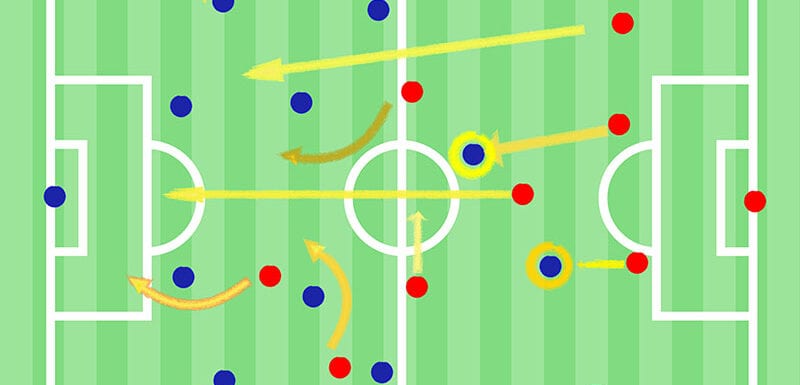How do you win the marketing game? Well, to start, you don’t just wing it.
Top marketers always have a Game Plan. And while it’s flexible and can change on the fly, for the most part, they stick with it.
This time of year, most marketers are just winding up their annual planning. They’ve taken a look at trends, projections, possible new products or targets, what’s working, and what needs to change.
But that’s just the groundwork. Based on this information, they create a plan for the coming year.
What goes into this Game Plan? Strategies for how they’ll do 3 things:
- Engage existing and new customers
- Build relationship
- Sell
After all, that’s the core of any marketing plan, right?
Now, let’s dig deep into the 3 strategies that go into a smart Game Plan.
1. Engage
Engagement should happen at every stage of your funnel, but at the top of the funnel, it’s especially important. That first impression you create with a prospect determines the likelihood they’ll listen to anything else you have to say.
How do you ensure you make a good first impression?
Well, to start, you need to know your audience. Talk to them about the things they care about in a way that makes sense to them. Don’t be the formal 3-piece-suit guy talking to stay-at-home moms.
Which brings me to the second point: Be real. Be human. Be yourself. Seriously, there’s no way you can build trust if you’re trying to be something you aren’t. (And people are smart enough to know the difference.)
To engage people, you need to talk like a real person. And by the way, that’s true even if you’re a big brand. There are, after all, real people behind your brand. Let their voices be heard.
How do you get started?
One of the best places to focus on engagement is social media. That’s where you can start conversations, join discussions, ask questions, and answer them.
But don’t forget your other channels. In social, engagement is the priority, but you need to be engaging at every touch, no matter what channel or where it falls in the funnel.
2. Relationship
People buy from people they know, like and trust. When given a choice, all else being equal, they buy from the seller they like.
Relationship is how you move people from general interest in your product to the actual purchase. So how do you build relationship?
There was a day when the sales conversation was a one one-on-one thing, the customer talking with a salesperson. But these today, customers are usually two-thirds of the way through the buying process before they start talking to you.
That’s why your digital marketing needs to have the look and feel of human interaction. It’s got to answer questions, provide useful information, and help people *like* your brand.
Just as you did when focusing on engagement, be yourself and be real. But you also want to make sure you focus on helping your market succeed, not just selling to them.
Start by being crystal clear about who you serve. Identify your marketing and provide deep solutions to their problems.
Of course, to do that, you need to be connected with them so you know what problems they’re struggling with. So think of this as engagement-part-2. Engagement and relationship really do go hand in hand.
How do you get started?
To build relationship, I recommend diving deep into content marketing. As Brian Massey says in his book, Your Customer Creation Equation, content is one of the ways you charge your marketing batteries.
Content is one of the most cost-effective interim ‘products’ you can produce.
For evidence of this, look no further than the blog at QuickSprout.com. Neil Patel has built a huge following simply by over-delivering through content.
In general, you can nurture relationship through social media, your blog and your email. But the core of your efforts will be content creation. Use social media and email to build your lists and get that content in front of them.
One more tip: Go beyond content creation. Be present. Respond to people. Let them know you’re in business to help.
3. Sell
Ultimately, this is what you’re in business for. It just can’t look that way to your prospects.
It’s important to keep your profit goals in your back pocket, only pulling them out when you’re optimizing your campaigns. On the front end, from your customers’ perspective, you’ve got to be focused on helping them solve their problems.
That’s why your game plan has to start with who you serve. Not what you sell or do. Keep the focus on your customers. Create powerful offers that you know your customers are interested in. And build out your funnel to take them from interest to the final sale.
How do you get started?
Building a well-optimized sales funnel requires skills in copywriting, design and conversion optimization. Technically, you need to be able to create great offers, build attractive landing pages and be able to drive traffic to those pages.
That means you’ll need to develop systems for
- Generating traffic: advertising, email marketing, CTAs in your blog and other content, etc.
- Engagement: content marketing, email marketing, and more
- Lead generation: creating lead magnets and content upgrades that people can’t resist
- Presenting your offers: landing pages, reverse squeeze pages, upsells, and more
- Providing a Wow! experience that keeps people coming back for more
It’s important to develop your skills in all five of these areas or hire people who have. Then it’s a matter of mapping out your Game Plan and executing on it.
Consider ways you’ll get people’s attention… engage them with content and/or email… drive them to opt-in to your conversion funnel… present your offers… and provide a stellar customer experience throughout it all.
Map it. Do it. And I’m willing to bet you’ll see the results in your bottom line.



